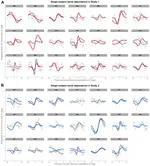How do subjective perception and memory shape one another?

Many of us believe that our senses provide an accurate reflection of reality. However, already back in the 19th century, Hermann von Helmholtz recognized that our perception is not a direct representation of the external world. Instead, it’s a subjective interpretation of nerve signals transmitted by our eyes, ears, nose, and other senses to our brain. Our past experiences and memories also shape this process of perception, blending with this sensory input.
One intriguing example is how the same radiological scan can be interpreted differently depending on the viewer’s prior experiences. The exact same structure might be identified as a potentially malignant tumor by one observer and as a benign abnormality by another, simply based on their previous exposure to similar images.
This idea that perception and memory shape one another continues to form the basis of many modern theories about the human brain. Surprisingly, though, research into memory and perception often remains separate. Memory researchers focus on how information is stored, processed, and recalled, while perception researchers study the cognitive and neural mechanisms underlying the recognition and interpretation of sensory input.
What is completely missing so far is a unifying theory that explains when and how exactly perception and memory interact and/or merge with each other and which specific mechanisms in the human brain make this possible. In the long-term, I aim to develop such a unifying theory.
If you are curious to learn more, check out some of my associated publications:
